Chúng ta sống trên Hành tinh Xanh, nhưng ngay cả ở đây nước ngọt cũng là một nguồn tài nguyên khan hiếm. Chỉ có 2% tổng lượng nước trên thế giới là nước ngọt, hầu hết trong số đó bị khóa trong các sông băng ở hai cực hoặc được lưu trữ sâu dưới lòng đất. Điều này có nghĩa là chỉ một phần rất nhỏ, 0,3% nước ngọt, được tìm thấy trong sông hồ. Đối với các ngành công nghiệp sử dụng nhiều nước đang tìm kiếm việc sử dụng nước bền vững, giấc mơ là khai thác vào đại dương và sử dụng lượng nước biển khổng lồ. Trong bài viết này, việc sử dụng nước biển để sản xuất hydro xanh được kiểm tra tập trung vào bước khử muối ban đầu trong quy trình hướng tới nước siêu tinh khiết. Các cân nhắc chính và các khía cạnh kỹ thuật được khám phá bằng cách trả lời các câu hỏi thiết yếu như: Nước biển có phải là nguồn nước khả thi cho hydro xanh không? Các vấn đề xử lý nước khi sử dụng nước biển cho hydro xanh là gì? Và bạn nên lựa chọn thẩm thấu ngược dựa trên màng hay bay hơi nhiệt?
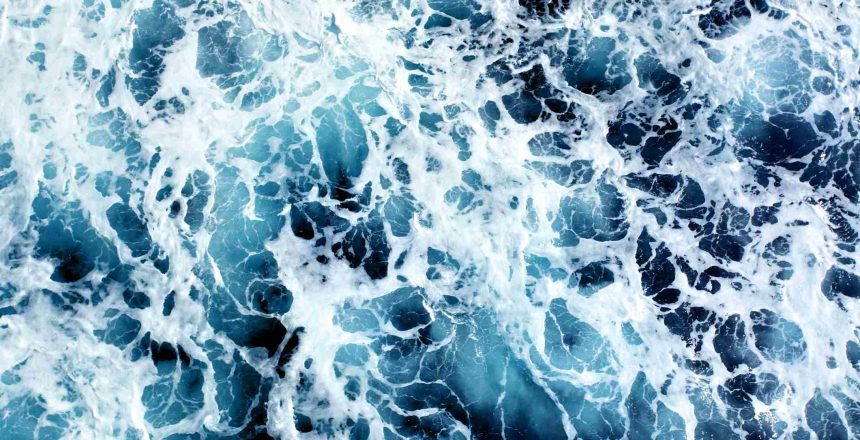
Viết bởi Henrik Tækker Madsen, Giám đốc Phát triển Ứng dụng, Silhorko-Eurowater – Công ty Grundfos, và Ozan Yucel, Giám đốc Phát triển Kinh doanh, Meco – A Grundfos Company
Tại sao nước biển có thể là tương lai của hydro xanh
Chỉ có 2% tổng lượng nước trên thế giới là nước ngọt, hầu hết trong số đó bị khóa trong các sông băng ở hai cực hoặc được lưu trữ sâu dưới lòng đất. Điều này có nghĩa là chỉ một phần rất nhỏ, 0,3% nước ngọt, được tìm thấy trong sông hồ. Hiện tại, hầu hết các dự án hydro xanh được thực hiện đều có quy mô nhỏ và do đó dựa vào nước uống hoặc nước xử lý có sẵn tại chỗ. Tuy nhiên, khi các dự án tăng quy mô, đây có thể sẽ không phải là một giải pháp khả thi. Một số yếu tố có thể thúc đẩy việc sử dụng nước biển:
-
- Địa lý học
- Tiêu chuẩn hóa
- Tính bền vững
Để tiếp cận với năng lượng tái tạo giá rẻ, các cơ sở hydro xanh sẽ được đặt trong môi trường khô cằn hoặc ven biển, nơi nước ngọt khan hiếm hoặc hoàn toàn không có sẵn và nơi nước biển là nguồn nước duy nhất có sẵn.
Nước biển là một loại nước tương đối đồng nhất với chất lượng tương tự trên các khu vực địa lý khác nhau, cho phép mức độ tiêu chuẩn hóa cao. Để giảm chi phí hydro xanh, tiêu chuẩn hóa có thể trở thành một công cụ quan trọng và việc sử dụng nước biển thay vì nguồn nước địa phương có chất lượng thay đổi có thể cho phép điều này cho hệ thống xử lý nước.
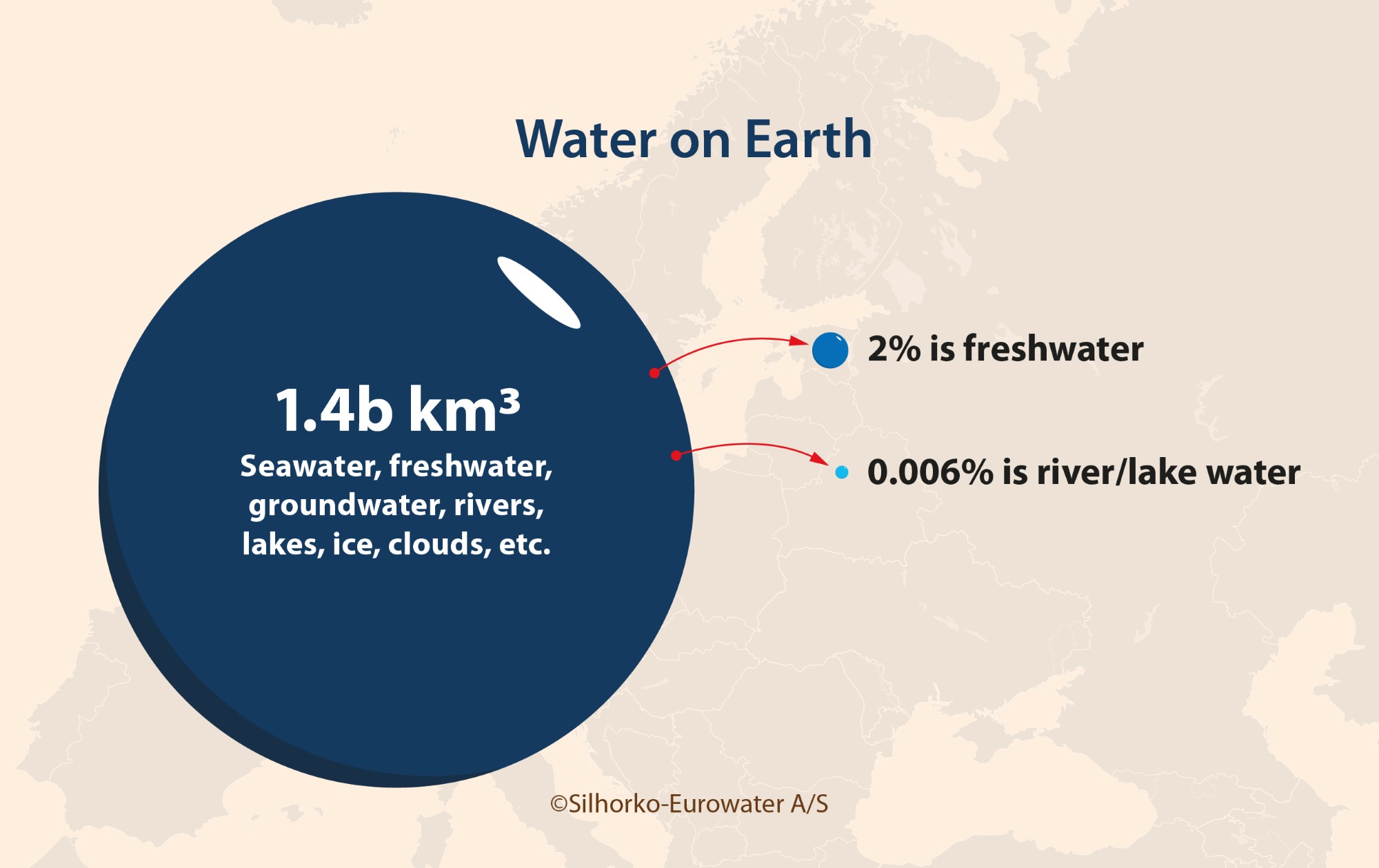
As a green technology, there is also a strong focus on not relying on drinking water resources, and use of seawater is a way to avoid this.
Freshwater versus seawater
When comparing the use of seawater with low-salinity freshwater resources like groundwater, river water, or wastewater effluent, two of the main differences are:
-
- Water footprint
- Energy consumption
Seawater is more water intensive than freshwater. To produce 1 m³ of ultrapure water for electrolysis you need around 1.5 m³ of freshwater, but up to 2.5 m³ of seawater. This also means that where the use of freshwater will generate around 500 L of wastewater for every m³ of ultrapure water, seawater will generate around 1,500 L for every m³ of ultrapure water. For seawater, the wastewater will be a brine solution that must be discharged safely. In comparison, the wastewater from freshwater plants can be more readily handled in a wastewater treatment plant.
A second concern is the energy consumption of turning seawater into ultrapure water. Depending on the desalination technology, desalination generally requires 5–10 kWh of electricity for every m³ of ultrapure water, sometimes even more, compared to 2–3 kWh of electricity for freshwater. However, this should be seen in comparison with the overall energy consumption of electrolysis, which will require a thousand times more, around 5,000 kWh of electricity.
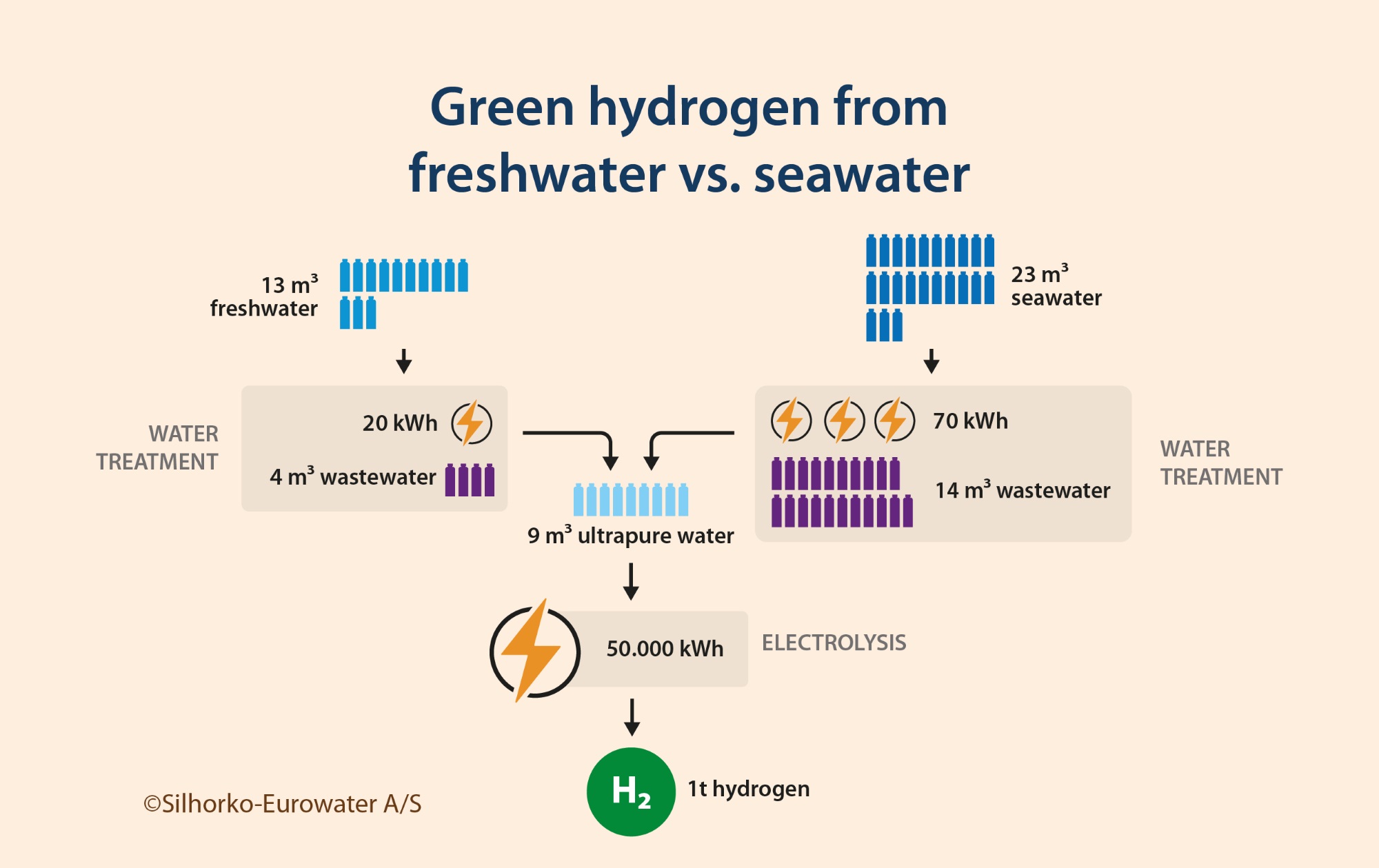
Desalinating seawater for electrolysis – design conditions
In electrolyzer systems, the stack takes up 40–60% of the total cost. The main job of a desalination system is to protect this investment by meeting a series of requirements:
-
- Product water of ultrapure quality
- Flexible operation
- Robust operation in harsh conditions
- Small footprint
- Cost effectiveness
Electrolyzers function optimally with ultrapure water, the quality of which is often stipulated in ASTM guidelines for type I–IV water. Type I water is commonly employed in the operation of PEM electrolyzers, while alkaline electrolyzers typically utilize type II or type IV water. Table 1 shows ASTM type I and type II water compared to seawater. To meet the requirements for type I quality water, the desalination system must reduce conductivity by a factor of 900,000, the concentration of sodium with a factor of 11,000,000 and the concentration of chloride by a factor of 19,000,000. In comparison, silica and organics need to be reduced by a factor of 3,000 and 20, respectively.
Green hydrogen electrolyzers operate with a high degree of variable load depending on the amount of renewable energy available and experience frequent starts and stops. The water treatment system must be able to handle this variation while maintaining water of high quality.
A portion of the market for seawater-based green hydrogen is expected to be located offshore. The desalination system must be able to operate properly under these harsh conditions without needing frequent service.
For green hydrogen plants in locations with limited space, for instance offshore platforms or containerized systems, compact systems with a small footprint are an advantage.
Finally, the water treatment solution must be cost-effective to contribute to reducing total cost of green hydrogen.
In addition to these, the size of the water treatment system should be matched against relevant electrolyzer sizes. A 10 MW system requires 2 m³/h of ultrapure water, while a 100 MW electrolyzer requires 20 m³/h. Larger electrolyzer installations will often consist of trains of these systems to obtain safety through redundancy and to achieve flexibility. A relevant range of size of water treatment systems for electrolyzers is therefore 2–100 m³/h.
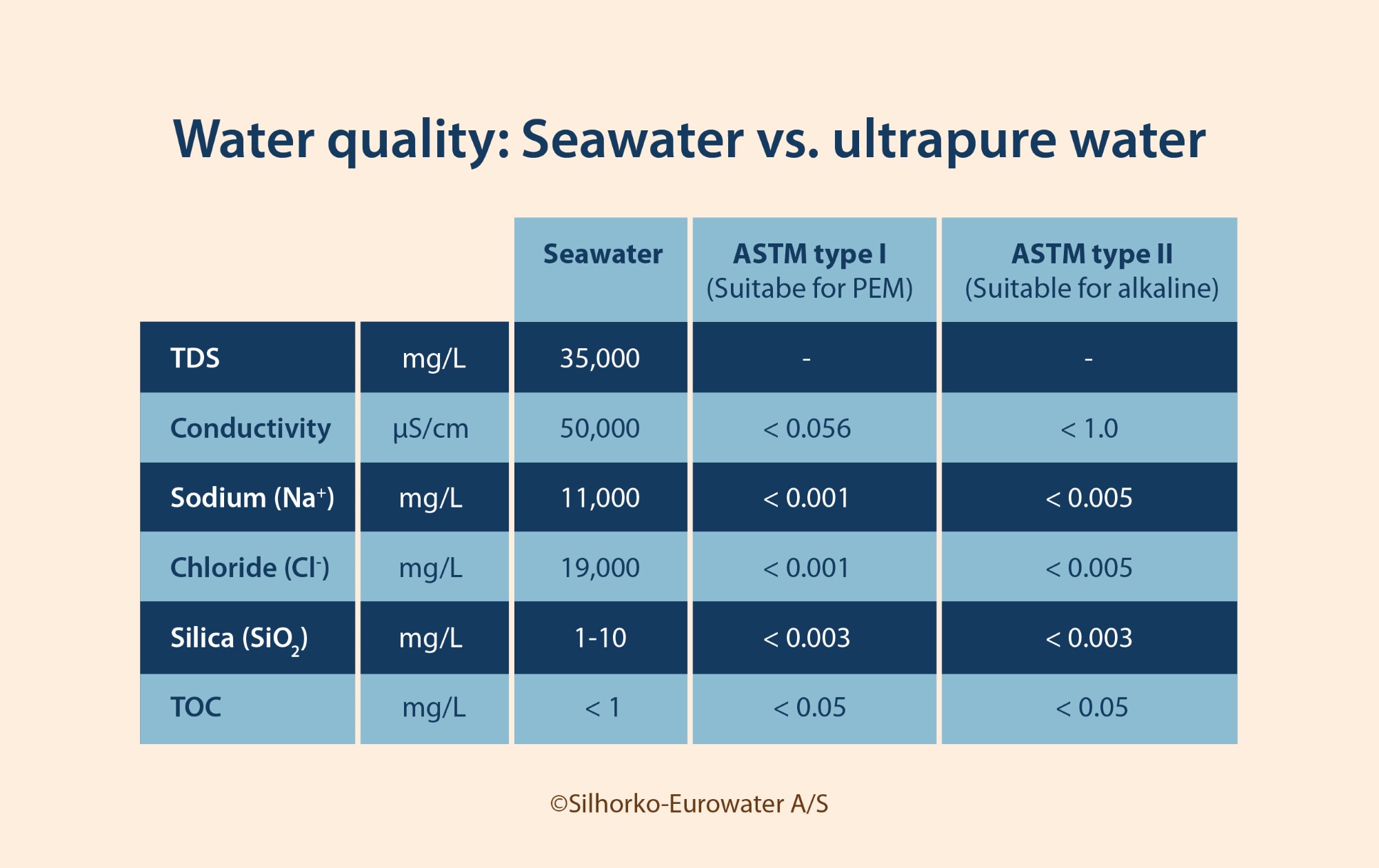
Table 1. Comparison of ultrapure water and seawater
Desalination technologies – SWRO and thermal
To desalinate seawater, there are generally two options:
-
- Seawater reverse osmosis (SWRO)
- Thermal desalination
SWRO operates by using high pressure to drive seawater through a semi-permeable membrane. The membrane retains most of the ions and molecules while allowing water to pass. Depending on parameters such as seawater salinity and temperature, a pressure of 60–70 bar is typically required. The high pressure in the membrane system is necessary to overcome the osmotic pressure of seawater.
Thermal desalination relies on thermal energy to evaporate water and then condense it back to distilled water. While there is only one type of SWRO process, there are several alternative thermal processes. For integration with green hydrogen electrolyzers, which generate waste heat between 50–70°C, the two most suitable thermal technologies are Vapor Compression (VC) and marine freshwater generators relying on Vacuum Distillation (VD).
VC utilizes a mechanical compressor to raise the temperature of water vapors that are used to drive the evaporation process. In contrast, VD relies on an ejector pump to create a vacuum, enabling evaporation at lower temperatures. Compared to other thermal methods like Multi-Stage Flash (MSF) desalination and Multi-Effect Distillation (MED), VC and VD are usually simpler, have a smaller footprint, and are more cost-effective for water flows relevant to green hydrogen plants.
VC can utilize the electrolyzer waste heat to preheat the incoming seawater and hereby lower overall energy cost, while VD can use the waste heat directly to evaporate seawater under vacuum conditions.
In the desalination industry, membrane-based SWRO is the prevalent technology. So why consider thermal desalination for green hydrogen? For two main reasons:
-
- Ability to utilize waste heat
- Combine water treatment and cooling
Places where thermal desalination is used today are characterized by access to cheap waste heat that can be used to drive the process. In electrolysis, about 20% of the electrical energy is lost as waste heat. This means that for every 1 m³ of ultrapure water that is electrolyzed, 1,000 kWh of waste heat is generated. In addition, if the waste heat is used to produce ultrapure water, the water treatment process will also cool the electrolyzer, eliminating the need for a cooling tower.
Comparison in the context of green hydrogen
To evaluate how well each desalination technology is suited for green hydrogen, they are compared based on the following parameters:
-
- Product water quality
- Robustness and flexibility
- Footprint
- Energy requirement
- Capital cost
Both SWRO and thermal desalination deliver high-quality product water, but thermal methods can typically achieve higher purity. SWRO systems will typically be able to produce water with 100–200 ppm NaCl, equal to 200–400 µS/cm. In comparison thermal desalination methods will deliver product water quality in the range of 2–10 ppm NaCl, equal to 4–20 µS/cm. This means that to be comparable in terms of water quality, a SWRO system must be followed by a second low pressure RO pass to further filter the permeate. Using a second RO step, operated at 10–20 bar, the water quality can be improved to 2–5 ppm NaCl or 2–10 µS/cm.
In terms of robustness, thermal desalination systems have a more durable design with fewer moving parts making maintenance simpler. Scaling is a challenge for both technologies, and they need a similar level of pretreatment to operate well. Once established, servicing typically occurs annually. Regarding ability to follow the varying production of the electrolyzer, both systems operate best under constant conditions, but SWRO systems are better suited for frequent starts and stops. However, thermal systems are better able to handle fluctuations in the feed water quality and temperature.
The size of water treatment plants varies depending on the model and brand, but rough estimates can be made and compared for relevant electrolyzer sizes such as 10 and 100 MW. Generally, thermal systems tend to be slightly larger than RO systems. A thermal system for 10 and 100 MW will have footprints of up to 6 m² and 25 m², respectively. In comparison, SWRO systems for the same capacities typically have footprints around 2 m² and 10 m², respectively.
As for energy consumption, a SWRO system needs around 3–5 kWh of electrical energy to produce 1 m³ of product water. A VC system needs approxiately 6–12 kWh of electrical energy to produce 1 m³ of product water. For other thermal desalination technologies, such as VD, 2–6 kWh of electrical energy and 100–200 kWh of thermal energy are typically required. Notably, the thermal input for these systems could to some extent be covered by the waste heat from the electrolyzers.
Capital costs are always difficult to assess directly. However, in the desalination industry, SWRO are generally found to have a lower CAPEX compared to thermal systems. This may be especially true for the smaller systems well suited for green hydrogen applications. In this range there are many available SWRO systems on the market ensuring high competitiveness on price. In comparison, thermal systems have mainly been used in niche applications and are therefore not available in the same volume. Thus, expect higher capital costs per m³ of water for a thermal desalination system.
Why not just operate directly on seawater?
A popular thought is that we avoid desalination completely and perform electrolysis directly on seawater. Schemes for direct electrolysis of seawater typically fall into two categories:
-
- Systems where seawater and the electrolyte solution are separated by a contactor membrane
- Electrolyzers with modified electrodes
In the first category, a few studies have claimed to be operating directly on seawater, while in reality they rely on water treatment using a contactor membrane. This could for instance be a forward osmosis membrane or a membrane distillation setup. These schemes do not avoid water treatment but suggest an alternative to traditional SWRO and thermal desalination. So far, no commercial breakthrough has been made for either of these technologies in desalination.
Electrolyzers equipped with modified electrodes to function directly with seawater are frequently presented as the most promising solution. Theoretically, it is possible to manufacture electrodes that can operate directly on seawater. However, such electrodes will be costly and will not bring added value. More energy is required to perform electrolysis on seawater compared to ultrapure water, and optimizing electrodes for these applications foregoes the opportunity for other optimizations, such as energy efficiency.
In conclusion, direct seawater utilization for electrolyzers is not a viable approach. Desalination must remain the initial step in the water treatment process.
Summary
Due to different drivers, seawater as a main water source for green hydrogen is likely to grow in the future. It will require more water and use more energy than systems based on freshwater, but the energy consumption for water treatment will still be significantly lower than for electrolysis, and it will consume no freshwater.
The main challenge for a green hydrogen desalination system will be the huge reduction in salt concentration required to meet electrolyzer quality standards. The special operating conditions for green hydrogen systems with fluctuating demand for water will also mean that the desalination system must be designed differently compared to what is normally done in the desalination industry.
Thermal systems have raised a lot of interest due to their ability to operate on waste heat, but in reality, this will not be enough. Thermal desalination systems that rely on heat still need access to electricity. Additionally, for these systems to function effectively, the temperature of the waste heat must typically be higher than 70°C. Therefore, while waste heat is beneficial, it alone cannot sustain the operation of thermal desalination systems.
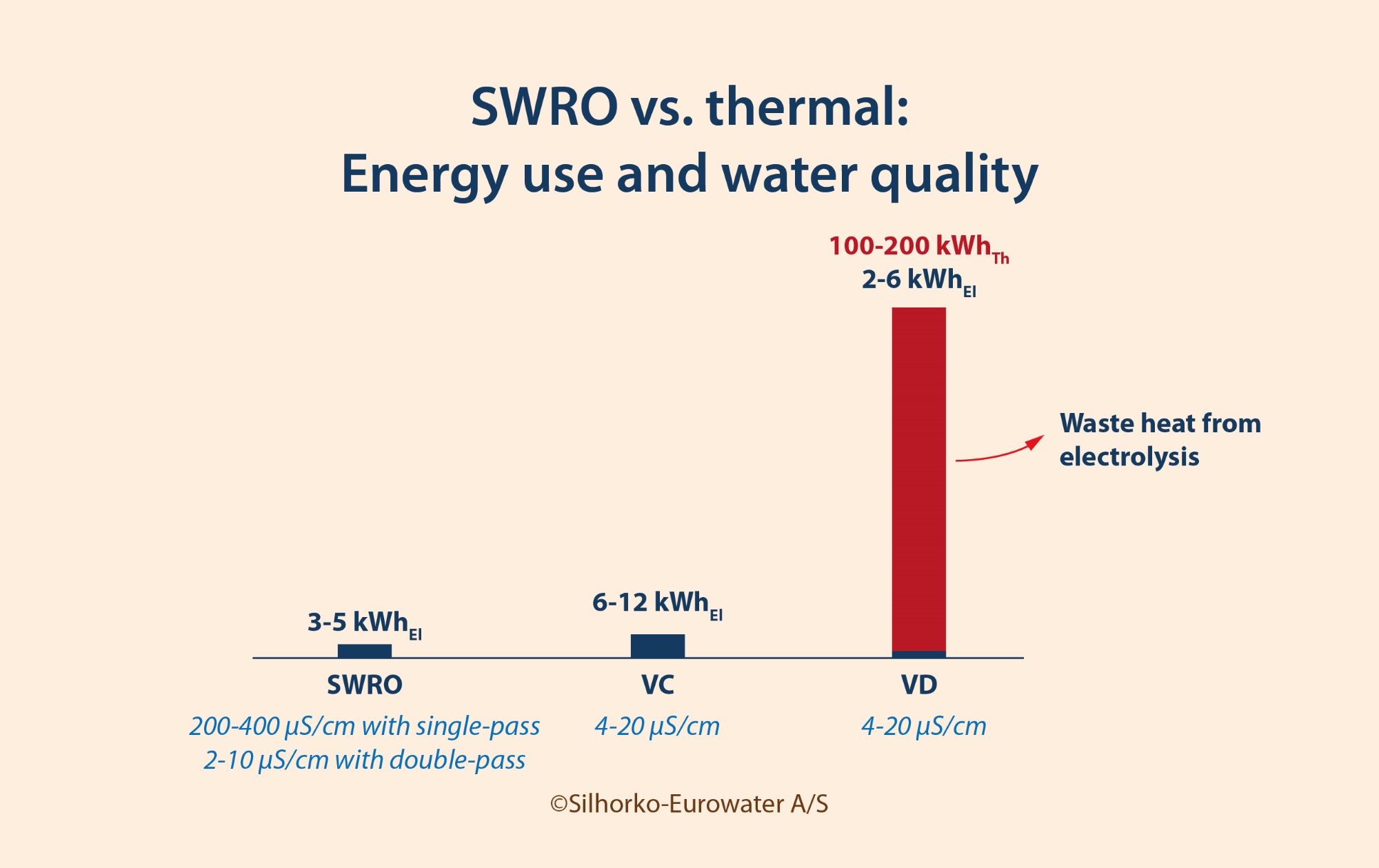
Khả năng kết hợp làm mát và xử lý nước - vì nhiệt được loại bỏ khỏi máy điện phân để tạo ra nước - là lợi thế thứ hai thường được đưa ra cho các hệ thống nhiệt. Tuy nhiên, các hệ thống nhiệt chỉ cần 100-200 kWh nhiệt để tạo ra 1 m³ nước siêu tinh khiết, trong khi điện phân cùng 1 m³ nước siêu tinh khiết sẽ tạo ra khoảng 1.000 kWh nhiệt. Do đó, một hệ thống xử lý nước nóng chỉ có thể sử dụng một phần nhiệt và không thể thay thế tháp giải nhiệt.
Trường hợp chính cho một hệ thống nhiệt sẽ là ở những nơi yêu cầu hệ thống mạnh mẽ và nơi nước sản xuất có thể được sử dụng trực tiếp trong máy điện phân kiềm hoặc đưa vào EDI hoặc giường hỗn hợp để đạt được chất lượng PEM. Các hệ thống này có thể tốn nhiều năng lượng và đắt tiền hơn so với các hệ thống SWRO, nhưng chúng sẽ cung cấp một hệ thống đơn giản hơn đòi hỏi dịch vụ tối thiểu.
Điều này có nghĩa là mặc dù không bao giờ có một câu trả lời, SWRO có khả năng được sử dụng trong hầu hết các trường hợp do lợi thế về giá cả, tính khả dụng và khả năng mở rộng.
Sử dụng nước biển để sản xuất hydro xanh không phải là giấc mơ trong tương lai - các giải pháp xử lý nước đã tồn tại ngày nay. Ngay cả đối với khử muối, chi phí xử lý nước sẽ thấp hơn nhiều so với các chi phí liên quan đến máy điện phân. Do đó, điều cần thiết là phải nhấn mạnh rằng việc sử dụng nước biển để sản xuất hydro sẽ không tạo ra trường hợp kinh doanh cho một nhà máy điện phân, nhưng thực hiện khử muối sai sẽ phá vỡ nó.
Mời đối tác xem các hoạt động của Công ty TNHH Pacific Group.
FanPage: https://www.facebook.com/Pacific-Group
YouTube: https://www.youtube.com/@PacificGroupCoLt






